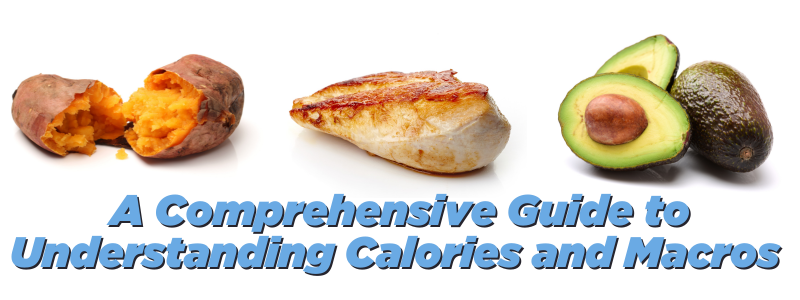Taking the steps towards your health and fitness goals, such as losing weight, gaining muscle, or maintaining a balanced diet, requires a solid understanding of calculating your daily calories and macronutrients (macros).
This guide will break down the process of determining your caloric needs and finding the right balance of protein, carbohydrates, and fats for your body.
1. The Lowdown on Calories and Macros
-Calories are the energy units you glean from food. Your body requires several calories to perform essential functions like breathing, digestion, and maintaining body temperature. Weight gain or loss depends on whether you consume more or fewer calories than your body requires.
-Macros (macronutrients) are the three primary nutrients that give us energy:
Proteins are vital for muscle repair, growth, and other bodily functions. Carbohydrates are the body’s primary energy source, especially for high-intensity activities.
Fats: These are crucial for hormone production, brain function, and energy storage.
2. Your Step-By-Step Guide to Calorie Calculation
Step 1: What’s Your Basal Metabolic Rate (BMR)? Your Basal Metabolic Rate (BMR) is the number of calories your body needs at rest to maintain basic physiological functions. Several formulas can estimate BMR, the Harris-Benedict equation being a popular one:
For Men: BMR = 88.362 + (13.397 x weight in kg) + (4.799 x height in cm) – (5.677 x age in years)
For Women: BMR = 447.593 + (9.247 x weight in kg) + (3.098 x height in cm) – (4.330 x age in years) To convert pounds to kilograms, divide by 2.205. To convert inches to centimetres, multiply by 2.54.
Step 2: Find Your Total Daily Energy Expenditure (TDEE).
Your Total Daily Energy Expenditure (TDEE) is the total number of calories you burn in a day, taking all activities into account. To calculate TDEE, multiply your BMR by an activity factor:
Sedentary (little or no exercise): BMR x 1.2
Lightly active (light exercise/sports 1-3 days a week): BMR x 1.375
Moderately active (moderate exercise/sports 3-5 days a week): BMR x 1.55
Very active (hard exercise/sports 6-7 days a week): BMR x 1.725
Extra active (strenuous exercise, physical job, or training twice a day): BMR x 1.9
This number indicates the total calories you need to maintain your current weight.
Step 3: Set Your Calorie Goal
Weight loss: Aim for a calorie deficit. Subtract 250-500 calories from your TDEE for a slow and sustainable weight loss of about 0.5-1 pound per week.
Weight gain: Aim for a calorie surplus.
Add 250-500 calories to your TDEE for a gradual weight gain of about 0.5-1 pound weekly.
Maintenance: If you’re happy with your weight, stick to your TDEE.
3. Splitting Your Calories into Macros Once you’ve determined your daily calorie needs, you can break those calories down into macronutrients. Here’s a straightforward approach:
Step 1: Determine Your Protein Intake Protein is essential for muscle repair and growth. A standard recommendation is to consume 1.2-2.2 grams of protein per kilogram of body weight.
For example, if you weigh 70 kg (154 lbs), aim for 84-154 grams of protein daily.
Calories from protein = grams of protein x 4 (as 1 gram of protein provides four calories).
Step 2: Set Your Fat Intake Fats are essential for hormone production and nutrient absorption. A good starting point is to consume 20-35% of your daily calories from fat.
For example, if your daily calorie goal is 2,000 calories and you choose 30% from fat, Calories from fat = 2000 x 0.30 = 600 calories.
Convert this to grams by dividing by 9 (as 1 gram of fat provides nine calories):
Grams of fat = 600/9 = 67 grams.
Step 3: Calculate Your Carbohydrate Intake Carbohydrates will make up the remaining calories after you account for protein and fat.
For example, if your goal is 2,000 calories, you’ve allocated 600 calories to fat and, let’s say, 400 calories to protein: Calories remaining for carbs = 2000 – (600 + 400) = 1000 calories. Convert this to grams by dividing by 4 (as 1 gram of carbohydrate provides four calories): Grams of carbs = 1000/4 = 250 grams.
4. Fine-Tuning Your Macros Everyone’s body responds uniquely to different macronutrient ratios. Consider tracking your food intake and results for a few weeks, and adjust your macros based on how you feel, your energy levels, and your progress towards your goals. If you’re not seeing the desired results, try adjusting one macro at a time.
For example, increase carbohydrates slightly and reduce fat if you’re sluggish.
5. Utilizing Tools for Simplicity There are plenty of tools and apps out there to aid you in tracking your calories and macros:
MyFitnessPal: A user-friendly app for tracking calories and macros.
Cronometer: Offers detailed nutrient tracking and insights.
6. Wrapping Up Calculating your calories and macros might seem overwhelming initially, but it becomes second nature with some practice. By understanding your body’s needs and how different foods contribute to your daily intake, you can make informed decisions that help you reach your fitness goals more effectively. If you have questions or need personalised advice on calculating your calories and macros, don’t hesitate to reach out. Your journey to a healthier you starts with knowledge and the right tools!
Need options for non-vegan / vegan protein sources? Read our blog here.



1 thought on “A Comprehensive Guide to Understanding Calories and Macros ”
Comments are closed.